11 best online course platforms to choose from in 2025
Getting students to finish online courses these days is a slog. (Just ask any teacher.)
Social media is fighting for their attention. So are their texts. And their life.
All while you’re trying to find more learners, create a structured (but not too loose) learner experience, and facilitate killer outcomes. And somewhere in a cobwebbed corner of your mind, a dozen unfinished tasks are playing ping-pong.
But if you choose the right online course platform, you can cut through the noise (and the cobwebs) and boost your course completion rates. Which means more reviews, referrals, and revenue.
So, if you’re curious about creating the best learning environment and experience for students—or just have a lot to teach the world and don’t know where to do it—in this article, you’ll learn:
- Why community-driven learning tends to wildly outperform the usual online approach
- The top 11 online course platforms on the market
- The software that gives your students the best chance of success
What is an online course platform?
An online course platform is a software solution that creators and businesses use to build, host, and deliver educational content, whether free or paid. These tools streamline learning programs with features like course creation tools, payment processing, and student management.
Marketplace vs. self-hosted platforms
When launching an online course, you’ll need to choose between a digital marketplace (like Udemy and Coursera) and a self-hosted platform (like Circle or Kajabi).
- Digital marketplaces are plug-and-play, so they make it easy for you to set up, launch, and market your course. However, they come with limited control over branding, pricing, and audience data.
- Self-hosted platforms give you full ownership of the student experience—from design to delivery. This flexibility allows for higher profit margins and deeper community engagement.
Unsure which to choose? This in-depth comparison should help.
Course platforms vs. learning management systems
Course platforms and learning management systems are similar and the terms are often used interchangeably, but there’s a subtle difference.
- Online course platforms make it easy for creators to design, sell, and deliver courses without needing a tech team or extended setup periods. They’re ideal for solopreneurs and small businesses.
- Learning management systems (LMS) are robust edtech solutions with advanced features like certifications, compliance tracking, and enterprise tool integrations. They work best if you’re scaling, serving larger audiences like universities, or building in-house employee upskilling programs.
The data behind community-powered course success
Note: The following insights are based on original Circle research, our community data, and general industry standards.
The completion rate reality
Most online courses go unfinished. Specifically, e-learning experts estimate the following completion rates for different course types and formats:
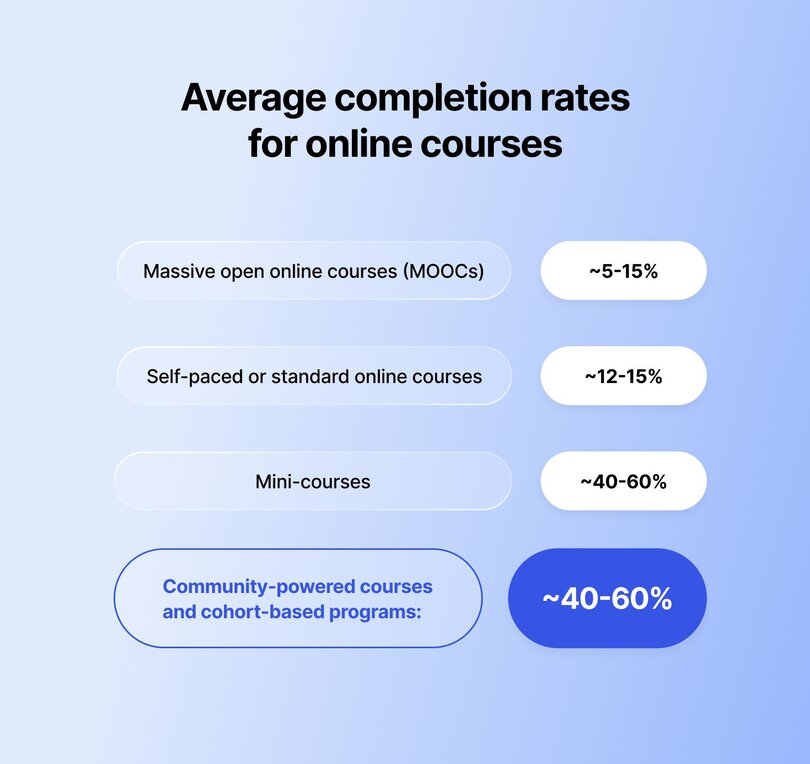
So…
What drives higher completion rates?
The online course platform you use is half of the equation. The other half, based on Circle community data and industry research, lies in how you design, deliver, and support the learning experience, including:
- Intentional onboarding → Tactics like “Start Here” spaces and kickoff calls often lead to higher course start rates, around 60-80%.
- Clear course progression and delivery → When learners can see their path forward with a paced curriculum, they’re less likely to get frustrated and more likely to stay the course (pun intended 😉).
- Weekly prompts and peer check-ins → These elements keep learners accountable and motivated, contributing to 40-60% completion rates, 3x higher than normal (15-20% without them).
- Shared wins spaces and feedback threads → Celebrating milestones together and encouraging learner input boosts engagement.
- Clear transformation focus → Putting the results learners will get front and center of your messaging throughout the course leads to better retention.
💡Peer engagement features can triple online course completion rates from 15% to 45%+.
How courses move the needle in Circle
At Circle, we know what makes online learners tick because we’ve seen 15,000 brands (and millions of people) test, reiterate, and succeed with community-powered courses:

📚 The movement is real: 65% of Circle communities (that's nearly 10,000 communities!) have already created at least one course—because they've seen what works
🚀 Learning powerhouses: These course-running communities don't mess around—they're averaging 5 courses each and reaching 425 students per course
📈 Real completion rates: While most online courses see 10-15% completion, Circle communities are crushing it with 40-60% of students actually finishing what they start
🔥 The engagement multiplier: Want to double your community's energy? Add courses. Communities with published courses see 95% more active members and 122% more direct messages
⚡ The ripple effect: Courses don't just teach—they transform entire communities, creating a cycle where learning drives conversation, connection, and commitment
The business impact of higher completion rates
Low course completion rates lead to less revenue over time, but higher completion rates mean more ROI.
How course completion rates impact your bottom line:
| Low completion rates lead to: | High completion rates deliver: |
|---|---|
| Poor reviews from incomplete courses | Glowing testimonials and case studies |
| Reduced word-of-mouth referrals | More opportunities to upsell |
| Lower customer lifetime value (LTV) | Strong brand reputation |
| Increased refund requests and chargebacks | Reduced customer acquisition cost (CAC) |
💡 Want to get the best course completion rates—consistently? Embrace the shift from content consumption to peer-driven transformation.
What to look for in an online course platform
Knowing what makes a great online course platform is key to choosing the right one. Here’s what to look out for:
Essential features
These are capabilities that should make up the foundation of every online course platform.
- 🛠️ Course builder and curriculum tools for creating and organizing the learning experience.
- 🧑🤝🧑 Community and interaction features like discussions, spaces, collections, group chats, and video calls to boost engagement and course completion.
- 💰 Payment gateways, subscriptions, and conversion optimization for seamless monetization.
- 📊 Analytics and progress tracking to monitor and improve performance (for both course content and students).
- 🎨 Design flexibility and branding to enable easy customization and learner-friendly interfaces.
- 🎯 Marketing and automation tools to drive sales, save time, and streamline processes.
Advanced course platform features
Basic course creation and delivery features are crucial. But to create truly transformative learning experiences, deepen engagement, and boost completion rates, you need a platform that incorporates community-driven elements.
- Peer interaction capabilities, like spaces where learners can connect, collaborate, and offer support. E.g., chat rooms, discussion forums, feedback threads, and P2P messaging.
- Group coaching tools that empower instructors and learners to co-create value, from breakout rooms and leaderboards, to polls, quizzes, live Q&As, and hot seats.
- Live cohort support functionalities that foster real-time connection and structured pacing. E.g., live calls, access groups, session replays, mini group chats, or automated event reminders.
- Accountability systems to help learners follow through on their goals, like check-in prompts and goal trackers. Peer accountability groups and scheduled assignments or reminders also apply here.
- Progress sharing features that encourage learners to celebrate wins and stay motivated. They include elements like shareable milestones, progress dashboards, public badges or certificates, and community updates or shoutouts.
Top 10 course platforms compared
1. Best online course platform: Circle
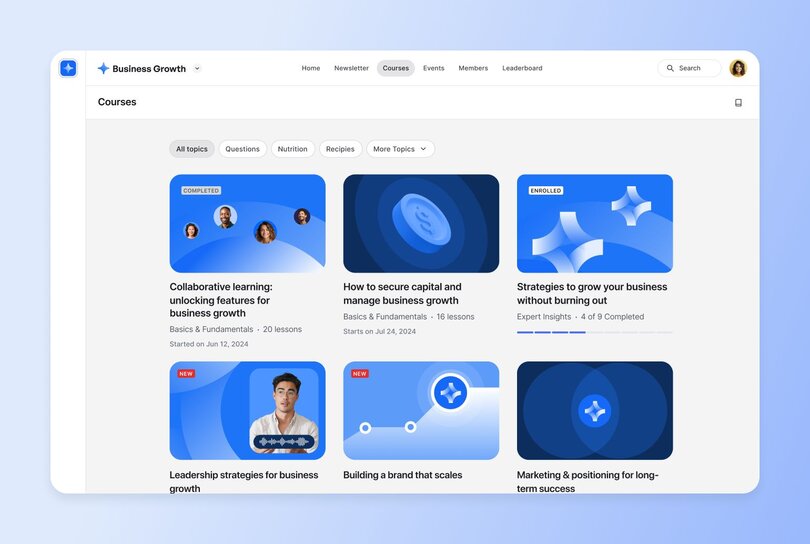
Circle offers an online course tool and community features designed for immersive learning and enhanced engagement. Ideal for creators, solopreneurs, coaches, and educators, it brings your educational content and community into one place—no more juggling multiple tools.
It also lets you deliver truly interactive student experiences like comment threads on lessons, office hours, coaching, live Q&As, and more.
Key features:
- Course builder with drag-and-drop editor that lets you create and customize a learning program in hours (instead of weeks).
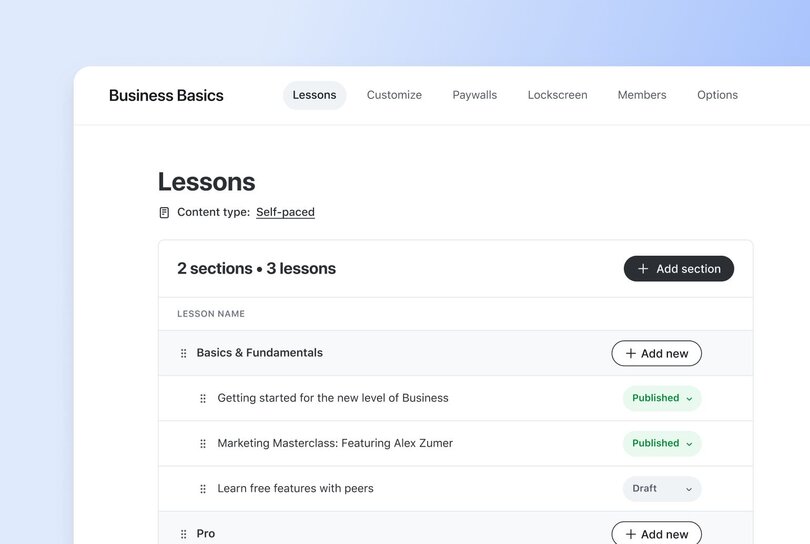
- Native community discussions within the same platform where your courses live: for hosting real-time conversations with learners, peer-to-peer chats, direct messages, comments, and text Q&As—either on your course lesson pages, within the broader community, or wherever you see fit.

- Live events and coaching (Q&As, streams, and office hours) for group or one-on-one engagement with students.

- Peer accountability tools, like leaderboards to gamify course progress, and VIP clubs for rewarding engaged students.
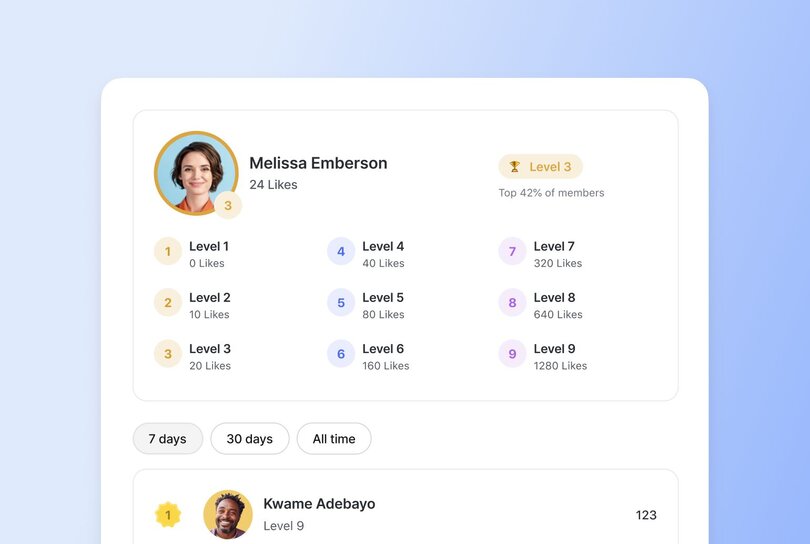
- Sales pages and paywalls for marketing, sharing pricing plans, and collecting payments without external tools.
- Mobile and branded apps for on-the-go learning on Android and iOS.
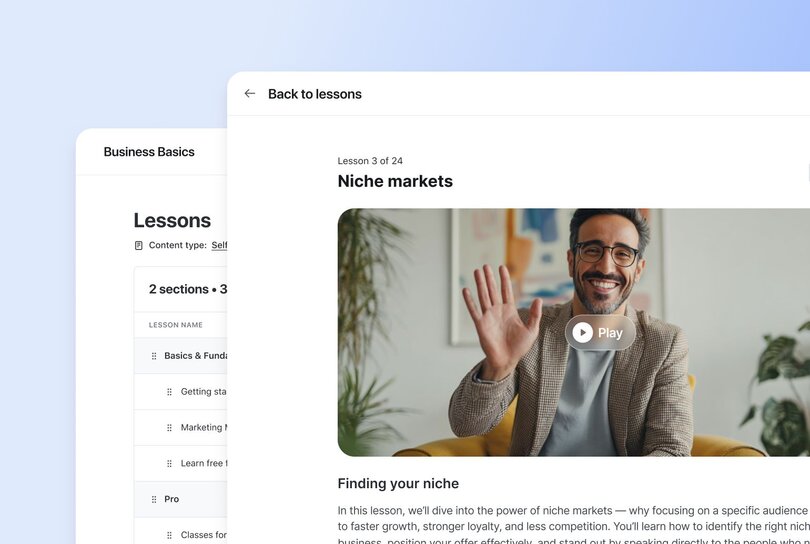
- Flexible course payments: Choose from a range of pricing options and paywalls that help you charge for one-off courses, previews, or ongoing community memberships.
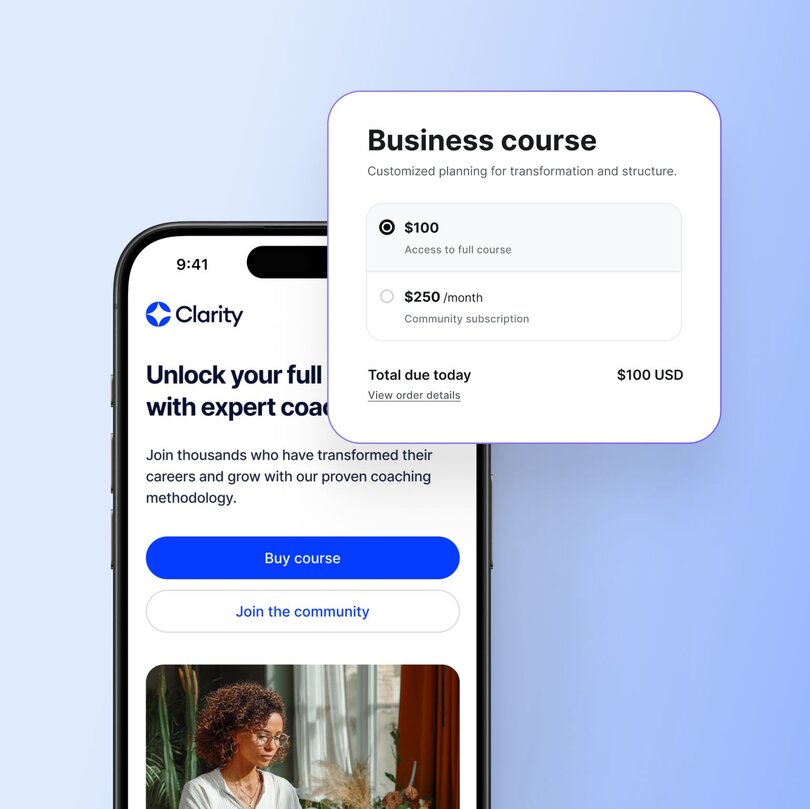
- AI chat agents to help guide learners and automate support.
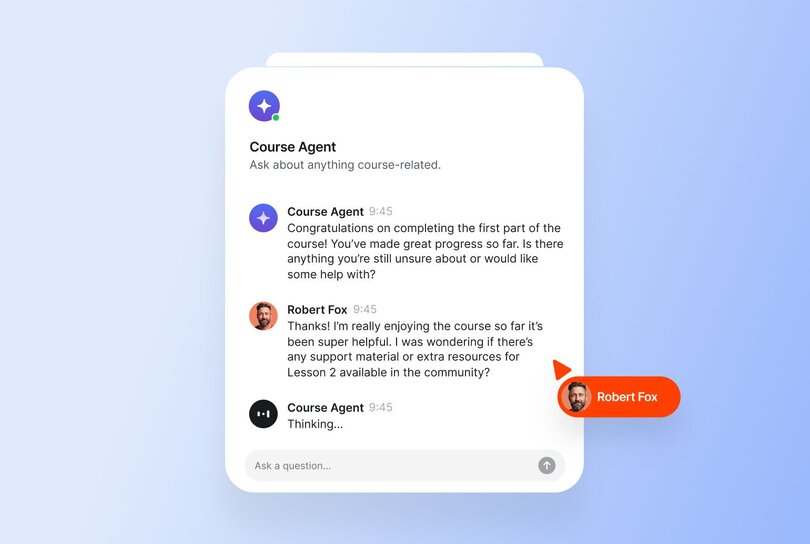
- Email marketing hub for sending broadcast messages, building marketing automations, and managing your learner base.

- Website builder for promoting your courses (and other offerings, if any) and showcasing their pricing
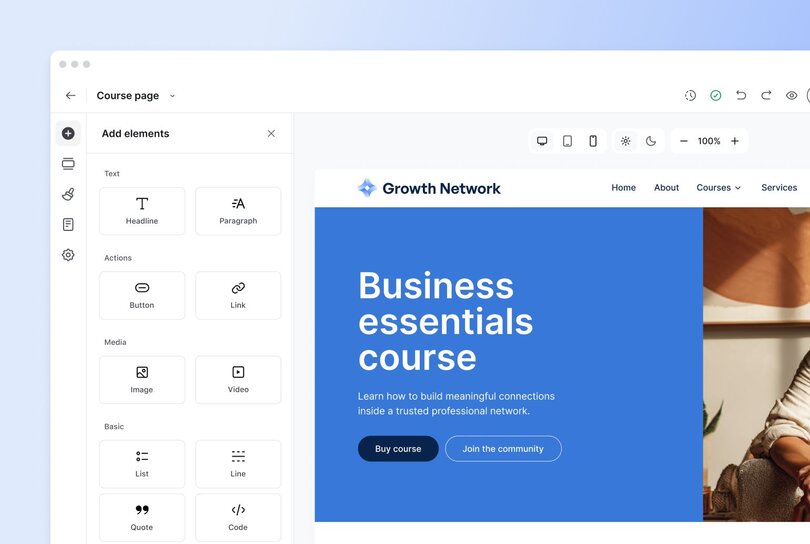
Pricing:
You can build your own ‘Circle’ starting at $89/month for core community features, plus unlimited courses, unlimited members, email marketing, a website and landing page builder, custom branding, analytics, and more. We also offer a 14-day free trial on most plans and some of the lowest transaction fees in the game (2%!)
Best for:
Creators, solopreneurs, coaches, and educators
Users say:
👍🏻 “We moved onto Circle after trying many platforms to be able to have our course content and community space in one space that was ours (vs a social media site or multiple platforms). They are constantly updating things…and many of the features we were missing when we signed up are now on Circle.”
| Pros | Cons |
|---|---|
| High course engagement and completion rates due to features | Not built for in-person learning |
| All-in-one solution (courses + community + webpages + events + email + automations + payments) | Can be hard to keep up with product improvements |
| Available on desktop and mobile (iOS and Android) | Doesn’t partner with academic institutions (but we do offer nonprofit discounts) |
| Deeply integrated course and community features |
Start your free 14-day trial of Circle today.
2. Best for launching your first course: Teachable
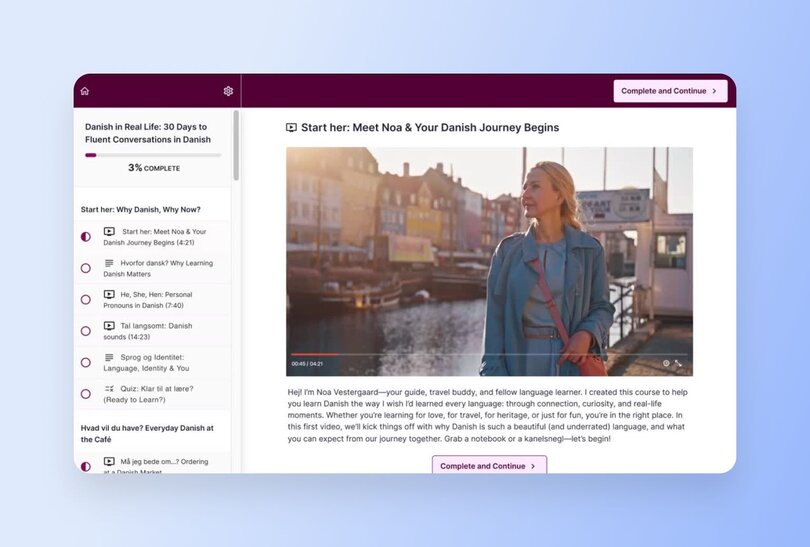
Teachable is a learning management system for subject matter experts looking to create and sell learning products like coaching sessions, digital downloads, and, of course, online courses. The app is easy to use and flexibly priced, making it a low-stakes option for new course builders testing the waters.
And while Teachable has recently expanded to memberships and community spaces, their engagement features are basic at best, and manual at worst. With Circle, you can automate workflows with courses that send out reminders, prompt completion, and re-engage students.
Key features:
- Drag-and-drop builder to create and customize courses
- Built-in AI tools for idea generation, content drafting, sales page creation, video transcription, and more.
- Custom domain and white label website for advanced customization
- Learner engagement tools like graded quizzes and certificates
- Community space for student-to-student and student-to-instructor connections that go beyond the course curriculum
Pricing:
Teachable’s plans start at $29/month (billed annually) with a 7.5% transaction fee and only 1 published product, such as a course, coaching, or download. Free trials are available for most plans.
Best for:
Creators and subject matter experts launching their first course
Users say:
👍🏻 “It (Teachable) allows you to fully customize your school from Home page to Thank you page.”
🤔 “I can't automatically send out reminders to students who haven't finished courses. While Teachable does integrate with Mailchimp, it only syncs the email address, meaning that any marketing has to happen manually.”
| Pros | Cons |
|---|---|
| Combines courses and community | No Android app, just iOS |
| Offers both low-cost and premium pricing | Relatively new community feature |
| Includes payment gateway | Only offers 1 published product in basic plan |
🔄 Not sold on Teachable’s community features?
Teachable is well-known and widely used as an online course tool, but its community features are relatively new.
Want a trusted alternative with both courses, community spaces, and email marketing?
Consider migrating to Circle. If a migration feels too complex or ill-timed at the moment, explore an integration instead (course on Teachable, community on Circle).
Here’s a great 2-part tutorial from Marc Sabatella of Outside Shore Music community on how to integrate Teachable + Circle.
Check out part 2 here.
3. Best if you have an unlimited budget: Kajabi
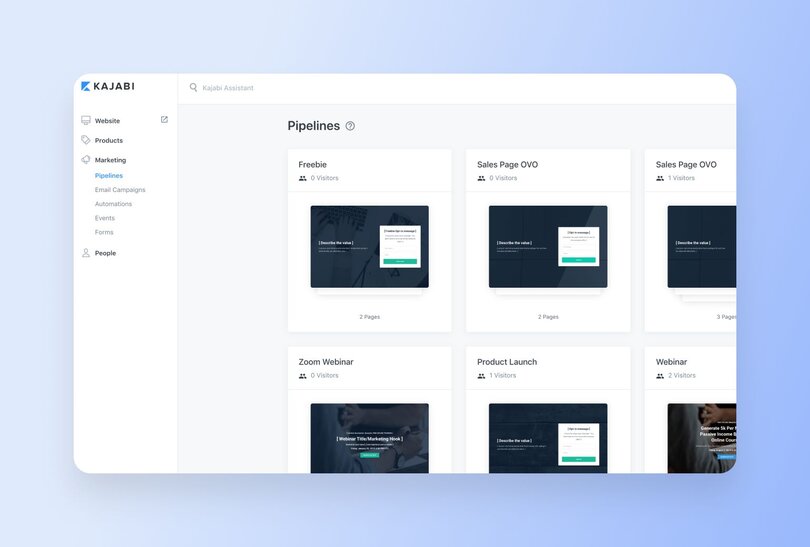
Kajabi is a suite of tools for selling online courses, coaching services, downloads, communities, newsletters, and podcast subscriptions.
It combines branding features, sales tools, and integrations, making it quite handy, especially if you have a big budget to spend on making your workflows more efficient.
However, it may cost you more than anticipated, according to community experts and strategists like Jordan Godbey.
Don’t have time to watch the video?
Here’s the TLDR, according to Jordan.
- Kajabi's community tool is "under-baked" - none of the high-end users he's spoken with actually use it
- The platform hasn't innovated fast enough despite being around for 10+ years
- Creates friction through multiple logins, websites, and tools - the opposite of what busy students want
- No cohesive integration between courses and community features
- Students struggle to get help or connect with others when courses are the "home base"
- Mobile experience and engagement are subpar
“There's a hidden cost in using 'old school' tools to run a modern online course or coaching business. If you have any kind of recurring subscription, then churn is your enemy.
How do you defeat churn? Remove as much friction as possible & make your program highly engaging. This is nearly impossible to do on Kajabi.”
—Jordan Godbey, founder of Growth Community and community strategist for creators like Ali Abdaal
Key features:
- Customizable templates and design tools for easy course building
- Built-in payments feature to simplify transactions
- AI tools for organizing course content and generating ideas
- Live sessions and community engagement features for robust student experiences
- Flexible commerce system that lets you optimize your funnel, grow learner satisfaction, and earn more
Pricing:
Paid plans start at $71/month with Kickstarter (billed annually), and users can access 14-day free trials for all Kajabi plans.
Note: Their Kickstarter plan only includes one published product, forcing you to pick between
- an online course,
- coaching,
- community,
- newsletters,
- podcasts, or
- downloads.
Best for:
Creators and educators selling high-ticket learning programs
Users say:
👍🏻 “We use Kajabi to host our eLearning courses. It is fairly easy to use, but can be pricey per month.”
🤔 “...most of the features don't work consistently, you spend more time dealing with the support team than you do running your business.”
| Pros | Cons |
|---|---|
| Single dashboard for creating, marketing, and selling courses | Relies heavily on 3rd-party tools, creating data silos and sync issues |
| Includes basic community elements | Community features are like a bolt-on addition |
| Full content ownership and control | No desktop presence |
🔄 Want to switch from Kajabi? You’re not the only one
Seth David of Nerd Enterprises found Kajabi's community functionality so limited that he created separate Slack workspaces for each course to give members proper support. This workaround cost him $1,000/month just for his mastermind group alone.
Here's how he describes his move to Circle:
“When I started producing courses on Kajabi I wanted to offer a unique experience by giving members a nice platform where they could get specific questions answered. So for each major course I would set up a Slack Workspace.
Fast forward, and Slack was getting ridiculously expensive. Suffice it to say, one of the first “draws” for me with Circle was “unlimited users” 😜.”
—Seth David, founder of Nerd Enterprises
Seth made the switch by taking advantage of our free concierge migration services—something Tamara Grominsky, former VP of Product Marketing at Kajabi, also used to migrate her entire business to Circle.
"At Kajabi, we acquired the tool that was the community builder, and so it's not integrated fully with Kajabi. It was actually designed for consumer communities, so some of the questions in the profile just have absolutely nothing to do with my professional community—but I can’t edit the fields."
—Tamara Grominsky, founder of PMM Camp, and former VP of Product Marketing at Kajabi
4. Best for on-the-go learning: Mighty Networks
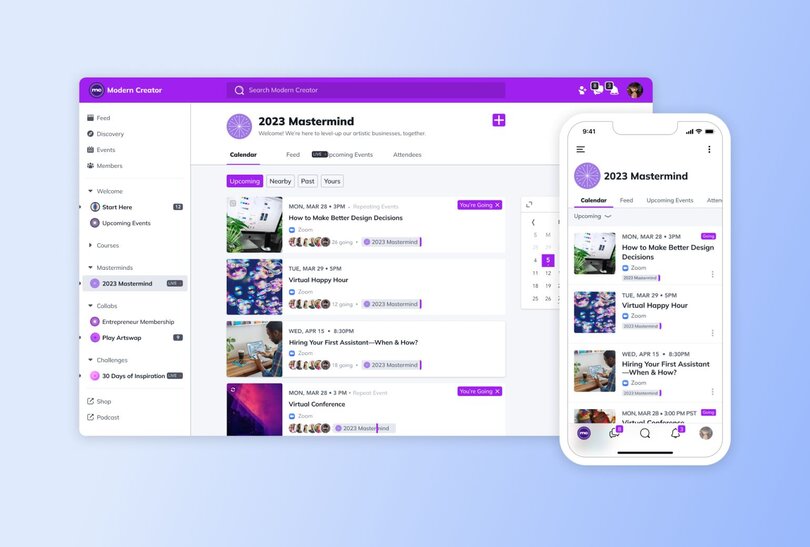
Mighty Networks helps users deliver engaging learning experiences, whether async or live. Its branded mobile app options and community-driven features support connected, interactive learning hubs.
But while alternatives like Circle offer solid mobile and desktop experiences, Mighty Networks prioritizes the former above all. It still has a web interface, but that element isn’t as highlighted or supported as its mobile accessibility.
Key features:
- Multimedia course builder that supports video, audio, and file attachments
- AI features, like a course outline generator, to make content creation easier
- Quizzes and assessments to aid learning and retention
- Web, Android, and iOS accessibility for student convenience and engagement
- Course payment options like one-time fees and cohort-based pricing
Pricing:
Mighty Networks offers a 14-day free trial, and its paid plans (that include courses) start at $99/month (billed yearly).
Best for:
Creators and entrepreneurs focused on mobile-first learning
Users say:
👍🏻 “We love that we can host courses, cohort spaces, and a community feed to keep everyone connected”
🤔 “For a platform positioned as an all-in-one solution, it lacks the seamless flow needed for a course-based business model. I'm now exploring other platforms that offer more flexibility and user-friendliness.”
| Pros | Cons |
|---|---|
| AI-powered | Basic course structuring, which makes it difficult to scale multiple programs |
| Includes community and membership tools | Limited layout and design options |
| Branded apps for self-hosting | Pricey and less accessible to creators on a budget |
5. Best for basic course experiences: Podia
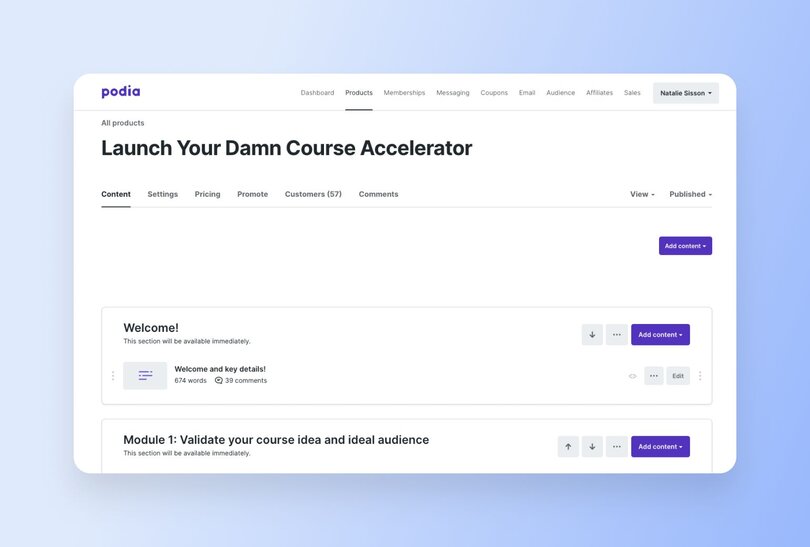
Podia is an all-in-one platform for building websites, running email marketing campaigns, and selling items—such as courses—online. Its customizations, integrations, and templates make it easy for creators to set up business workflows without starting from scratch or using clunky workarounds.
However, if you want a platform that’s custom-built for community-powered courses, rather than just being one of several generic features, it’s okay to opt for a more tailored option.
Key features:
- Online store that makes building and selling courses easy
- Webinars and workshops for live learning experiences
- Built-in discussion forums for announcements, Q&As, and peer-to-peer interaction
- Multiple course format options, including self-paced, cohort-based, on delivered on-schedule
- Presells and upsells to make course promotion easy
Pricing:
Podia offers a 30-day free trial and paid packages starting at $33/month (billed yearly).
Best for:
Solo business owners focused on digital products like online courses, or adding them to their existing offering
Users say:
👍🏻 “It (Podia) makes it easy to sell digital products and courses in no time.”
🤔 “There are one or two features I would like to have, like being able to copy lessons and modules from one course to another.”
| Pros | Cons |
|---|---|
| Ideal for solopreneurs and new founders | Not designed for big or enterprise brands |
| Unlimited courses on both plans | Limited community features |
| Extensive free trial period (30 days) | No branded apps or code-driven customizations |
6. Best for internal training: Thinkific

Thinkific supports online learning experiences with course, community, and assessment tools. Its monetization features work well for individual or institutional course creators selling to external audiences, but Thinkific stands out more for internal training use cases.
Unlike many other platforms, it explicitly supports customer education and workforce development, making it a strong choice for organizations interested in either.
Key features:
- Bulk course enrolment, custom user roles, and branded learning portals
- Assignments, surveys, AI-generated quizzes, and exams to ensure engagement and commitment
- Analytics dashboard for tracking engagement, performance, and revenue metrics, as well as driving data-backed decisions
- Self-paced, cohort, or scheduled courses so you can offer learners one or more options
- Zoom, CRM, and SSO system integration
Pricing:
Thinkific offers a 30-day free trial, and its paid plans start at $36/month (billed annually).
Best for:
Businesses and educational institutions focused on large-scale training or corporate learning
Users say:
👍🏻 “The course management system is straightforward and user-friendly.”
🤔 “Better analytics are possible and coding expertise is required for design customisation. Workaround are necessary for some integrations which can be inconvenient”
| Pros | Cons |
|---|---|
| User-friendly UI for instructors and learners | Occasional technical issues, like slow video loading |
| Strong course marketing and sales features | Basic analytics on lower-tier plans |
| No transaction fees on sales | Limited HTML editor |
7. Best for small-scale learning: Skool

Skool is a simple, online course marketplace for instructors who want to share their knowledge without the technical complexity. It combines a basic course builder with an integrated community, calendar, and gamification system.
While it lacks advanced features like complex learning paths or native integrations, Skool shines in its simplicity. Everything is streamlined—course hosting, learner discussions, and scheduling—making it perfect for small learning communities, group coaching, or those just getting started with digital courses.
Key features:
- Clean and intuitive course builder with support for video, files, and progress tracking
- Calendar integration for scheduling live calls, events, or cohort start dates
- Built-in community forum for learner discussions and peer interaction
- Gamification system with points and leaderboards to encourage participation
- Mobile-friendly layout with no setup or coding required
Pricing:
Skool offers two plans: one at $9/month and another at $99/month. Both include unlimited courses, members, and community access. It also provides a 14-day free trial.
Best for:
Coaches, creators, and educators who need a simple platform to host and deliver basic online courses with community features.
Users say:
👍🏻 “My favorite thing about Skool is the way it gamifies everything. Leaderboards, points, and levels give members something to work towards and keep them engaged.”
—Verified review from Freedom Bound Business
🤔 “No built-in quizzes or assessments to test student knowledge.”
—Verified review from Adam Enfroy
| Pros | Cons |
|---|---|
| Clean, distraction-free interface | No built-in video hosting—requires external platforms like Vimeo or YouTube |
| Built-in community and gamification tools | Limited customisation and branding options |
| Simple pricing with unlimited courses and members | No native live streaming or webinar functionality |
⇆ Circle vs Skool
Skool is an all-in-one space for hosting courses and community, but its simplicity can also be a limitation. If you need something more powerful and flexible, creator Marley Jaxx thinks you should consider Circle.
Here’s the TLDR, according to Marley:
- Every Skool community looks the same - lacks visual differentiation and branding flexibility, which makes it hard for communities to stand out
- Basic analytics only - missing the deep insights needed for strategic decisions
- Basic automation capabilities that fall short of what's needed for scaling
- Simple gamification features without advanced customization options (and not all communities use gamification for engagement!)
- Not built for long-term growth and advanced community management needs
- Lacks enterprise-level features for serious community builders
“Here's the bottom line: if you're cool with the basics, Skool might be enough. But if you want to build something truly epic, Circle's got the tools to make it happen: customization, automation, data. It's all there ready to take your community to the next level."
—Marley Jaxx, award-winning filmmaker and expert in video creation, YouTube growth, and content strategy.
8. Best for integrations and flexibility: LearnWorlds

LearnWorlds is an AI-powered learning management system for course creators. Like Thinkific, customer and employee training are some of its key use cases. With integrations like Zapier and flexible customizations, LearnWorlds helps brands connect their existing tech stack and workflows.
Key features:
- AI assistant for course creators to generate program outlines and text-based content
- Interactive videos, assessments, live sessions, social activities, and more to drive course engagement and completion
- Bundles, coupons, and subscriptions to help with course promotion and sales
- Advanced course insights to inform decision-making
- Extensive integration options with tools like Zapier, HubSpot, Salesforce, and Zoom
Pricing:
LearnWorlds’ pricing starts at $24/month (annually). However, this plan also includes an extra +$5 charge every time someone new enrolls.
Best for:
Course creators who want flexible, multi-integration course delivery
Users say:
👍🏻 “Their (LearnWorld’s) support team and academy offer rich assistance as you create”
🤔 “Wish there were additional incentives or badges relating to course completion as opposed to just community discussions.”
| Pros | Cons |
|---|---|
| Interactive learning features like quizzes and assessments | No built-in email marketing tools, requires 3rd-party integration |
| Comes with a website builder and community tools | Complex UI that can get overwhelming for new users |
| Offers a mobile app builder and white labeling | Top features like white labelling only come with higher-tier plans |
9. Best for professional discoverability: Udemy
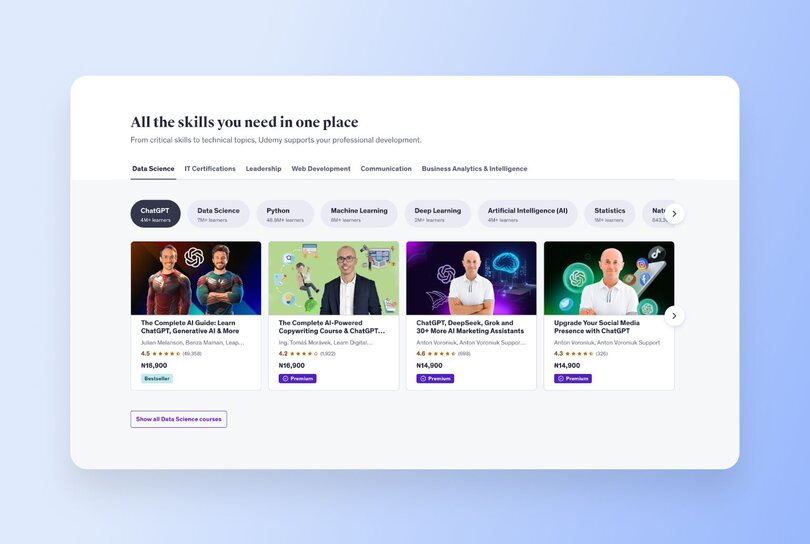
Udemy is a course marketplace where instructors across industries offer on-demand learning. Named in Time’s 2024 list of top edtech companies, it’s popular among students who want self-paced learning and businesses building employee upskilling programs.
Note: Udemy Business is a corporate learning solution that lets companies access a curated course library. Businesses enroll their employees, who can then take courses from approved instructors.
Unlike some platforms that support various digital products and include advanced community features, Udemy focuses on courses and basic discussion forums. While it’s easy to get set up, course creators have very minimal ownership of the overall student experience, from prospect to graduate.
Key features:
- Instructor dashboard and curriculum pages to keep things organized
- Support team to answer instructor questions and review sample course videos
- Teaching center and online community of experienced instructors to guide new users
- Custom coupons for offering enrolment incentives to prospects
- Global promotions tool and Udemy Business program to drive course traffic
Pricing:
Launching a course on Udemy—paid or unpaid—is free. However, some revenue share scenarios apply based on factors like promotions, taxes, business program membership, and more.
For example, if you bring the learners, you get the majority of revenue (~97%). However, if learners discover your course via the platform, you get only ~37%.
Best for:
Industry experts looking to test the online course waters
Users say:
👍🏻 “Udemy is a great platform to sell courses online, it's easy to use, simple to add courses and they do the marketing campaigns for their users.”
🤔 “(The) web based version (of Udemy) is more limiting than (the) mobile app.”
—Verified review from Capterra
| Pros | Cons |
|---|---|
| Easy to use | Cohort-based learning is only offered in Udemy Business |
| Launching courses is free | More lucrative for those with a stronger network because revenue depends on where students come from |
| Published instructor club for guidance and networking | Little room to customize learner experiences |
| Limited community spaces, mostly available via Udemy Business or third-party integrations |
10. Best for academic courses: Coursera
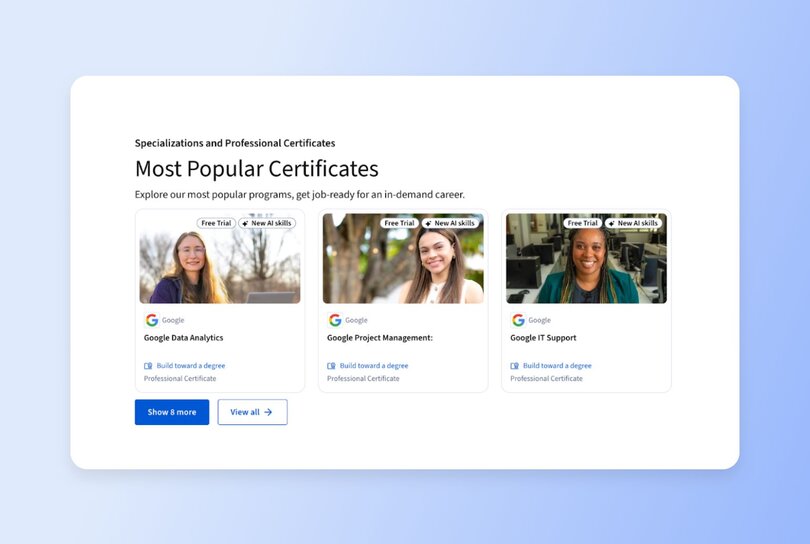
Coursera is an on-demand learning hub that’s home to thousands of MOOCs. Known for its academic rigour, universities, colleges, governments, and organizations use it to provide professional training, certifications, and degrees.
Though similar to Udemy, Coursera has been around for longer and offers more formal, comprehensive, and (sometimes) accredited courses. Also, solo creators can only publish courses on Coursera if they collaborate with the platform’s higher education or industry partners.
Key features:
- AI-assisted course authoring tool to keep training materials relevant and up-to-date
- Auto-generated suggestions for course learning objectives, outlines, and descriptions
- Professional certificates and degrees to boost student employability post-learning
- LMS integration so you can connect the platform to your existing learning management system
- Partnerships program for universities and industry-leading brands looking to reach more learners across the world
Pricing:
Becoming a Coursera partner is free, but you’ll need to pay for marketing support services and additional content production.
Best for:
Universities, colleges, governments, and organizations that want to offer virtual learning options
Users say:
👍🏻 “Our Google Career Certificates (via Coursera) have proven to be an effective way to help people prepare for well-paying, high-growth jobs.”
🤔 “Software support is not easily reachable.”
—Verified review from Capterra
| Pros | Cons |
|---|---|
| Partner universities and businesses can publish and give their students and staff access to multiple courses | Does not encourage course continuity and completion enough; lacks early alerts on potential dropouts |
| Powerful analytics and customization tools | Not very accessible for solo experts |
| Aligns learning with real-life applications | AI task-grading is not always accurate |
How to choose the right platform for you
Are you just starting out or looking to upgrade? The right online course platform for you is Circle, because it is the best self-hosted solution with community features custom-built for solo creators and brands. The table below shows why.
| Platform | Type | Upside | Downside |
|---|---|---|---|
| Circle | Self-hosted | Combines courses and community seamlessly for solo creators and brands | Simple analytics tools |
| Teachable | Self-hosted | Good for beginner course creators | Relatively new community features |
| Kajabi | Self-hosted | Lots of integrations | Costs add up quickly |
| Mighty Networks | Self-hosted | Good for on-the-go learning | Low web and desktop focus |
| Podia | Self-hosted | Many monetization tools for creators | Limited community elements |
| Thinkific | Self-hosted | Supports internal training | Low focus on external audiences |
| Skool | Self-hosted | Easy-to-use features | Not great for large learning groups |
| LearnWorlds | Self-hosted | Integrations and flexibility | Per-learner pricing plus base subscription fee |
| Udemy | Marketplace | Great for course discoverability | Limited control over learner experiences |
| Coursera | Marketplace | Includes certifiable courses | Solo creators can’t publish courses |
FAQs on online course platforms
What is the best online course platform?
While there's no single perfect solution for every use case, we’re confident that we’re the best course platform for everyone from beginners to advanced users because we've solved the industry's biggest problem: course completion rates.
While most platforms deliver disappointing 10-15% completion rates, Circle consistently achieves 40-60%+ completion rates. That's not just a minor improvement—it's the difference between failed courses and thriving learning businesses.
Here's why Circle stands out from every other platform:
- The only true all-in-one solution: Instead of juggling multiple tools like most creators do with platforms like Kajabi (where users report spending $1,000+/month on workarounds), Circle gives you courses, community, email marketing, websites, live events, and mobile apps—all seamlessly integrated in one place.
- Built for real results: With 65% of our 15,000+ communities already running courses and averaging 425 students per course, we've proven what works. Our community-powered approach drives 95% more active members and 122% more engagement than course-only platforms.
- Designed for everyone: Whether you're a beginner launching your first course or an advanced educator scaling multiple programs, Circle's drag-and-drop builder gets you up and running in hours (not weeks), while our advanced features grow with your business.
- Proven by the data: When completion rates directly impact your reviews, referrals, revenue, and reputation, choosing Circle isn't just about features—it's about your business success. That's why creators consistently migrate to Circle from platforms like Teachable, Kajabi, and Mighty Networks.
The real question isn't which platform is "best"—it's which platform actually helps your students succeed. That's Circle.
What course platforms support community features?
While Circle, Kajabi, Mighty Networks, LearnWorlds, and Thinkific all offer community features, most bolt them on as an afterthought.
Circle is built community-first, which is why we deliver 40-60% completion rates versus the industry standard 15%. The difference? Real engagement beats basic forums every time.
How much should I expect to spend monthly on a course platform?
Most course platforms range from $24-$500+ per month, but here's what makes the investment decision clearer: you're not just paying for course hosting—you're paying for student success.
While basic course platforms like LearnWorlds start at $24/month (plus $5 per enrollment), they can really only deliver 10-15% completion rates. Circle starts at $89/month but delivers 40-60% completion rates—that's 3-4x better student outcomes.
More importantly, Circle isn't just a course platform. For $89/month, you get:
- Course creation tools (like every other platform)
- Built-in community features (worth $100+/month if bought separately)
- Email marketing hub (typically $50+/month standalone)
- Website and landing page builder (usually $30+/month)
- Live events and coaching tools (often $100+/month elsewhere)
- Mobile apps (custom app development costs thousands)
- Payment processing with industry-low 2% fees
Compare this to competitors like Kajabi, where users often spend $1,000+/month on additional tools to fill gaps, or platforms that force you to cobble together 4-5 different services to match what Circle provides natively.
The real question isn't "What should I spend?" but "What can I afford to lose in student dropouts and tool complexity?" With 65% of Circle's 15,000+ communities already running courses—and averaging 425 students per course—the ROI speaks for itself.
Can I run a membership and a course in the same place?
Yes, and Circle makes this seamless. While other platforms require complex integrations or separate tools, Circle natively combines courses, memberships, community spaces, and payments in one unified experience—no workarounds needed.
What's the average online course completion rate?
Just 15%—a shockingly low number that reflects how most platforms treat courses like static content libraries.
Circle's community-powered approach delivers 40-60% completion rates because we turn passive consumption into active peer-driven transformation.
Do community features really improve course outcomes?
Absolutely. Community features can triple completion rates from 15% to 45%+.
Circle's data from 15,000+ communities proves that courses with peer interaction, accountability systems, and progress sharing consistently outperform isolated learning experiences.
Which platform is easiest for non-tech creators?
Circle. Our drag-and-drop builder gets you live in hours, not weeks, and we back it up with dedicated customer success managers, VIP technical support, live training sessions, and an active creator community—support that scales with your needs.
How much money do online courses make?
Online courses can generate anywhere from $500-$50,000+ monthly, but your platform choice directly impacts these numbers. Higher completion rates (like Circle's 40-60%) lead to better testimonials, more referrals, and higher customer lifetime value.
What is the most used online learning platform?
Coursera dominates the academic space, but for solo creators and brands, Circle is rapidly becoming the go-to choice. With 65% of our communities running courses and averaging 425 students each, we're proving that community-powered learning is the future.